
Characterful Opinion-Divider
The 861 is a true reference player, but one that divides opinion. There are people who say it’s the most real sounding player and there are those who find it square and “digital” sounding. The truth, as always, lies somewhere in the middle. Speaking for the Wadia are its immense 3D soundfield that is both wide and deep. It also has the best bass I’ve ever heard in a digital component. It is rock solid, articulate, deep and powerful. Its best area however is in the mids that are very natural and acoustically convincing. I haven’t heard better piano or drums on other players.

This player is also capable of lifelike dynamics and can be truly thrilling. Because of the filtering that Wadia uses there is less pre- and post ringing which might explain why it is so good with transients and soundstaging, but the same filter causes the highs to roll off gently which is audible. It is also this filter that makes the player sound dry, especially in the treble and although it sounds very colourful, it can for these reasons sound too controlled and too dark depending on the partnering components. But when carefully matched (open system, good rack and musical cables), this player can be extremely engaging.
Wadia 25
The Wadia 25 DAC has similar overall characteristics as the 861 CD player, but the two deviate in important aspects. What the 25 has got going for it is that it is more articulate than the 861 and can be said to have better PRAT. The 861 counters with a fuller, richer sound with more finesse and better soundstage layering, especially when used with Clocklink, and while no Wadia is truly very fluid, the 861 is less prone to dryness as the 25.

Above: in my 2005 setup the Wadia 861 was initially used in combination with Bryston 7BST mono amps and B&W Nautilus 804 speakers. There was no preamp. Although Wadia themselves preach the virtues of leaving out the preamp, the only advantage I see of doing so is that the bass really is speactacular that way. The trouble however is that the control that is so pleasant in the bass carries over to the mids and treble, resulting in a sound that is often too dry, lacking fluidity and air.

Above: 2007 setup with Jeff Rowland Synergy 1 preamp added.
Accuracy vs Dryness
It is my theory that when bass is reproduced squarely and accurately then this is desirable. But when the treble is too, then you can start hearing the digital nature of the sound, or at least this seems to be the case when dealing with certain digital filters.

Wadia Sound
The Wadia sound started quite fluid (in Wadia terms) with the 2000/WT2000 and 7/9, then became drier with the 850 and 860. The 861 in an absolute sense can not be considered to be very fluid or supple, but with careful tuning and component matching, it can be. More recent CD players such as the S7i, 581 and 781 have the most open and airy treble of all Wadias so far, but they also sound less sonorous in the bass. In generic it could be said that the Wadia sound evolved from dark and solid to more neutral and more balanced.
There’s one more thing about this player, and perhaps any VRDS based machine: esepcially in winter, the transport has to run every day to sound its best, so don’t expect it to sound spectacular after it has been left idle for a week. After playing about 3 cd’s it loosens up and portrays the fluidity that it is capable of.

Conclusion
A true reference player, but one that divides opinion. There are people who say it’s the most real-sounding player and there are those who find it square and “digital” sounding. The truth, as always, lies somewhere in the middle. For me, it is a classic with a unique character that never goes out of style.
More Wadia Reviews
Wadia 12
Wadia 25
Wadia 26
Wadia 27ix GNSC
Wadia 171i
Wadia 121
Wadia S7i
Wadia 581
Wadia 781i
Everything you always wanted to know about Wadia
Wadia Company Special
CD Mechanism Masterpieces – Wadia (including 861 and 861SE)








Hallo Christiaan,
Je schrijft op deze site ook dat de speler pas goed gaat klinken na het draaien van 1 of 2 cd’s, zelfs als de speler al goed opgewarmd is. Enig idee waarom dat is, want ik zou geen verklaring weten.
Mvg, jeroen
I suspect it is to do with the mechanical construction of the VRDS clamping system. Alternatively, it may have to do with the ageing capacitors in the servo control system which might only be powered when reading data. Do note I am not a technician and this is just speculation.
After spending $8,000 on repairs to my beloved 860x, I am very interested in buying the 861 if the price is reasonable. I use Jeff Rowland Model 10 Amo and SynergyII Preamp. I am elderly, but my true ‘restorative’ is Musica. I beg you for any advice, my fellow lover of ‘Sound’? Ed Nizolek NYC 212-222-6986 email: ednizolek@gmail.com and cell ph 646-549-7347 Mille grazie
Hi Ed, I no longer have the 861 but if you’re looking for one they should not be very hard to source on the second hand market. Try hifishark.com, it is a website that indexes all second hand ads on all of the major other 2nd hand sites. I did a quick check and found several for sale around the 4000 USD mark. FYI the 861 SE sound a little better than the regular 861 but the difference is only in the transport mechanism and the price is quite a bit higher. Then again, these tend to be newer than the regular 861s. The 861 GNSC has electrical tweaks by a licensed company that make it sound fuller and more organic but with a Model 10 and Synergy, I’d suggest the standard or SE model is fine and you don’t need these tweaks.
Hello
Congratulations for your device présentations and comparisons
Concerning the Wadia 861SE are there the sound différences between “symétric” and “asymetric” connections ?
And is there a drop of performances by using a preamp.
Many thanks for your feed back
Kind Regards
René
Hi Rene, Yes, XLR and RCA on an 861 sound a little different. Mostly due to the characteristics of the cables used (where balanced cables often sound different from single-ended coaxial designs), but also inherently so. (internally, the RCA outs are driven by an extra opamps) The XLR outputs sound smoother and more spacious while the RCA outputs sound tighter and more controlled. Still, it is not a matter of better/worse, more of synergy with your preamp and system. Personal taste is the deciding factor.
Hello
Many thanks for your feed back
We like a lot dynamic music, maybee the s7i version could be better for me
Kind Regards
René
861 sounds fuller, darker, and more robust; S7i sounds faster, more agile, and more open.